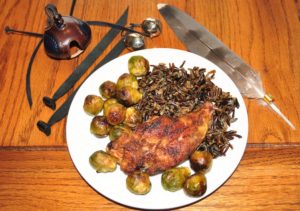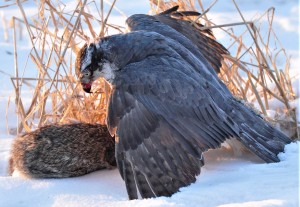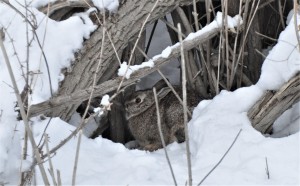Photography courtesy of Lowell Washburn, all rights reserved.
Rabbit hunting is just one of those things that I can’t seem to outgrow. But then, I guess I’ve never really put much effort into quitting the pastime. For me, chasin’ rabbits has been a long running endeavor. I became hooked on the sport at an early age when, as a .410 toting fifth grader, I was completely captivated by the sight of a winter cottontail bounding across the snowy backdrop of a farm country landscape. I fell in love with rabbit hunting as a kid; and find it no less enjoyable today.
Adaptable and abundant, Iowa cottontails are found statewide. Bag limits are liberal [10 daily], and the five-month open season runs until February 28. Although cottontails provide outdoor enthusiasts with countless hours of fun and exercise; the rabbits’ collateral value may actually exceed the high-quality recreation they so ably supply.
The outdoor version of ‘The Other White Meat’, rabbits are incredibly tasty and amazingly nutritious. A serving of rabbit meat contains more protein but less calories, fat, and cholesterol than equal amounts of chicken, beef, or pork. An important link in the natural food chain, rabbits have been a long-favored menu item of owls, foxes and, of course, humans. Back in the Day, everyone hunted rabbits. By everyone, I mean everyone. Kids, dads, Grandpas; it didn’t matter – no one passed up a good shot at a fat bunny. When suppertime rolled around, skillet fried rabbit was a common cold weather entrée.
Although I still enjoy fried rabbit on a fairly regular basis, I’m no longer carrying that old .410 shotgun. These days, my rabbit hunts are conducted in the company of trained goshawks instead. Over time, it’s proven to be an excellent and mutually beneficial working relationship. As native inhabitants of far northern forests, goshawks appear to relish crisp winter weather as much as I do. Like good bird dogs, trained hawks have the potential to improve with age and experience. I’m currently flying a male ‘gos that I’ve nicknamed “Attila”. Hunting together for the past nine seasons, we’ve chased everything from mallards and pheasants to snowshoe hares. Insanely aggressive and confident beyond reason, “Attila” routinely lives up to his namesake – that famous and feared leader of the Huns who was so taken by the species’ unsurpassed ability to catch wild game that he had an image of the goshawk emblazoned on his helmet. After nine years of hunting in every situation imaginable, “Attila” has become a bird that no rabbit wants to see coming in its rear-view mirror. Once the hawk has attained radar lock; it’s pretty likely that we’ll both be eating some rabbit.
February is one of our favorite months for pursuing cottontails. We especially enjoy taking to the woodlands during or immediately following heavy snowstorms; the game sits tight and the winter landscape is never more beautiful. Our daily strategy is simple but effective. The hunt begins by slowly exploring a vegetated marsh edge or by methodically weaving our way through dense woodlands. I probe the cattails, kick at brush piles or push through brambles while the hawk anxiously rides my gloved fist. The longer we walk, the more amped up the raptor becomes. What the hawk knows from experience is that sooner or later, a cottontail rabbit will burst from cover. What I know from experience, is that the hawk’s reaction to the sight of fleeing game will be instantaneous and explosive. The chase is on and, at least to my way of thinking, it’s a much more exciting way to obtain dinner than by reaching into the frozen food section of your local market.
But don’t start melting the butter just yet. No matter how good the hawk or how fleet the rabbit, the hunt’s outcome is never certain. Goshawks and rabbits have been sharing the same habitats for eons. Predator and prey are superbly matched, and regardless of how many times the event is witnessed; each new hunt develops its own unique and fast moving, never-before-seen choreography. After months of dodging everything from coyotes to horned owls; the easy rabbits are long gone. When routed from cover, February cottontails know exactly where they need to go and how to make all the right moves while getting there. Sometimes the high-speed maneuvers work; sometimes they don’t.
Today’s outing has favored the hunters. The twisting, high speed chase ended abruptly as the hurtling forms of predator and prey merged into one. As always, the conclusion of a successful hunt has become a moment to cherish. Sitting on the snow nearby, I drink in the stark beauty of the winter landscape while the hawk claims his portion of the kill — voraciously consuming the heart, liver, and a better part of the rabbit’s front quarter. When his meal is finished, the hawk jumps back to the fist while I place my share of the cottontail into the game bag.
Although the hawk likes to eat his catch on the spot; I prefer my meat just a bit more done. Later this evening, the hind legs and juicy back straps will be pan fried to a golden brown. By now, darkness will have engulfed the countryside. Sitting atop his perch, the goshawk appears to be fast asleep. My guess is that he’s already dreaming of tomorrow’s hunt.
LW




 Susan Judkins Josten
Susan Judkins Josten Rudi Roeslein
Rudi Roeslein Elyssa McFarland
Elyssa McFarland Mark Langgin
Mark Langgin Adam Janke
Adam Janke Joe Henry
Joe Henry Sue Wilkinson
Sue Wilkinson Tom Cope
Tom Cope Kristin Ashenbrenner
Kristin Ashenbrenner Joe Wilkinson
Joe Wilkinson Dr. Tammy Mildenstein
Dr. Tammy Mildenstein Sean McMahon
Sean McMahon